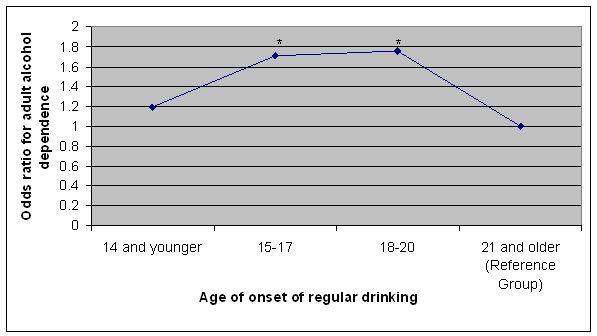Adolescent drinking is an important problem in the US. The CDC (2010) estimates that 65% of children under 18 drank alcohol in 2009, with 52% consuming more than 12 drinks per year. But, how dangerous is alcohol to adolescents? Current research suggests that 11-14 year olds are especially vulnerable to physiological and environmental ‘shocks’, including stress and alcohol consumption (Grant & Dawson, 1998). Today’s DRAM reviews a study examining the link between age at alcohol initiation and future drinking problems (Guttmannova et al., 2011).
Methods
- This study utilizes data collected as part of the Seattle Social Development Project (SSDP).
- The SSDP consists of 808 people, recruited as fifth graders in Seattle public schools serving high crime areas in 1985.
- Participants reported their past-month drinking annually until the 12th grade, and every three years beginning at age 18. The SSDP has data through age 33.
- Researchers recorded the age when participants first consumed any alcohol and when they initiated regular drinking.
- ‘Any alcohol consumption’ was defined as self-reported drinking “more than as sip or two” of alcohol on any occasion.
- ‘Regular drinking’ was defined as self-reported drinking on three or more occasions per month.
- Of this sample, 692 (86%) initiated any alcohol consumption before age 21 and had complete alcohol consumption data through age 33.
- Researchers used the Diagnostic Interview Schedule (DIS) to assess the consequences of drinking based on the DSM-IV diagnostic criteria.
- Participants endorsing one or two items on an assessment were considered alcohol misusers.
- Participants endorsing three or more items on any one assessment were considered alcohol dependent.
- Researchers created models to predict risk of adult alcohol misuse and alcohol dependence based on age of any drinking and age of regular drinking.
- Researchers divided participants into groups that initiated any drinking before age 11, from age 11 to 14, from age 15 to 17, from age 18 to 20, or at age 21 or older.
- Only five participants (0.7%) initiated regular drinking prior to age 11; for analysis, researches collapsed to two youngest groups into a single 14 or younger group.
- Researchers divided participants into groups that initiated any drinking before age 11, from age 11 to 14, from age 15 to 17, from age 18 to 20, or at age 21 or older.
- Participants completed the DIS five times starting from age 21 through age 33.
- Models controlled for socio-economic status, demographics and other drug use.
Results
- Participants who began regular alcohol consumption from ages 15 through 17 (Odds ratio [OR] = 1.71, p < .05) and 18 through 20 (OR = 1.85, p < .05) were at significantly greater risk of developing lifetime alcohol dependence than those initiating regular drinking at 21 or later.
- Neither initiation of any alcohol use at any age nor initiation of regular alcohol use before age 14 related significantly to future alcohol misuse or dependence.

Figure. Odds of adult alcohol dependence versus age at initiation of regular drinking.
* indicates p < .05. Click image to enlarge
Limitations
- The SSDP measured self-reported past-month alcohol consumption. Depending on the month administered, this method might have led to an over- or underestimation of alcohol consumption. The self-report nature of the data might also have introduced bias.
- Guttmannova et al. did not track the number of drinks consumed beyond ‘any’ and ‘regular.’ Thus, the relationship between heavy or binge drinking and future problems is undetectable. Furthermore, the survey did not distinguish among the types of beverages.
Conclusions
These results do not support the hypothesis that children who initiate drinking from ages 11 through 14 are especially vulnerable to future alcohol problems. Instead, it seems that the initiation of regular drinking at any age from 15 through 21 might predispose children to future alcohol dependence. It is unclear why regular alcohol initiation before age 15 does not significantly elevate the risk for developing alcohol dependence. It is possible that those aged 14 or younger might have fewer drinking opportunities. For example, alcohol might be difficult to acquire and social pressure to drink might be less than for older counterparts. This situation can result in less chance to experience the pleasurable aspects of drinking. Furthermore, early adverse experiences with alcohol might discourage further drinking. This discrepancy between the current study and past work might reflect the retrospective nature of past studies compared to the prospective design of this study. Future research might investigate whether this effect is due to psychological, social, biological or a combination of causes.
— Daniel Tao
What do you think? Please use the comment link below to provide feedback on this article.
References
Grant, B. F., & Dawson, D. A. (1998). Age of onset of drug use and its association with DSM-IV drug abuse and dependence: Results from the National Longitudinal Alcohol Epidemiologic Study. Journal of Substance Abuse, 10(2), 163-173.
Centers for Disease Control and Prevention. (2010). Youth Risk Behavior Surveillance – United States, 2009 (No. SS-5). Atlanta, GA: Centers for Disease Control and Prevention,.
Guttmannova, K., Bailey, J. A., Hill, K. G., Olivia, J., Hawkins, J. D., Woods, M. L., et al. (2011). Sensitive periods for adolescent alcohol use initiation: Predicting the lifeime occurrence and chronicity of alcohol problems in adulthood. Journal of Studies on Alcohol and Drugs, 72(2), 221-231.





ved12 April 5, 2012
Alcohol addiction is now a days very serious issue not only in US but also many other countries are suffering from this problem. This affects the social health of the country. Alcoholism makes children addicted to such drinks and it affects their health. Alcoholism is when you have signs of physical addiction to alcohol and continue to drink, despite problems with physical health. Many times it is resulted in death.